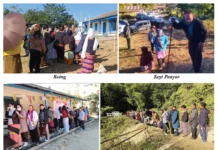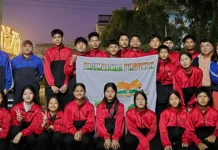[ Temi Pabo ]
Introduction
Arunachal Pradesh is situated in the extreme Northeastern part of India, in the Trans-Himalayan region, and has a long international border. This beautiful land of the rising sun was popularly known as NEFA (North-East Frontier Agency) until 21 January, 1972. It was administered by the president of India through the governor of Assam, acting as his agent. The NEFA attained the status of a union territory from 21 January, 1972, under the provisions of the North-Eastern Areas (Re-organisation) Act, 1971, with the new name of Arunachal Pradesh, under the charge of a chief commissioner, with its headquarters in Shillong, the capital of the state of Meghalaya. From 15 August, 1975, this union territory was endowed with a Legislative Assembly, having a chief minister with a Cabinet of four ministers to assist the lieutenant governor, appointed on the same day as the administrator of the union territory. The first general election to the 30-member Arunachal Pradesh Legislative Assembly was held in 1978, constituting a landmark in the political history of the territory. The headquarters of this union territory was then shifted from Shillong to Itanagar, under the then Subansiri district, in 1978. Arunachal attained the status of a state on 20 February, 1987.
How the BEFR Act, 1873, came up
The Bengal Eastern Frontier Regulation (BEFR) of 1873 was a policy that restricted the movement of people into the Northeast of India. It was the first administrative policy of the British in the region. The BEFR Act of 1873 was a policy that established an ‘inner line’ to limit movement in the Northeast of India. It was also known as the inner line regulation.
Purpose
– To protect the cultures and identities of indigenous tribes.
– To prevent the influx of migrants.
– To protect religious, social, and customary laws.
– To protect ownership and transfer of land.
– To protect the administration of civil and criminal justice.
– To protect the commercial interests of the British Empire.
Implementation
– The regulation prohibited outsiders from entering the area beyond the inner line without a pass.
– It also prohibited outsiders from purchasing land in the area beyond the inner line.
– The inner line permit (ILP) was implemented as part of the regulation.
Current status
– The ILP system is still in place to protect the cultures and traditions of the tribes living in the area beyond the inner line.
– The ILP states are Arunachal Pradesh, Nagaland, Mizoram, and Manipur.
– Foreigners need a protected area permit (PAP) to visit tourist places.
The rules and pledges of indigenous tribes
Arunachal comprises more than 26 major tribes and 120 sub-tribes, with their own traditions, customs, rich cultural heritage, and indigenous faith and beliefs in the festivals of the state since time immemorial. Every tribe is governed by what is called an apex organisation, and its student wings, like the NES and the ANSU, for the Nyishi community, the GWS and the GSU for the Galo community, the Adi Bane Kebang and the AdiSU for the Adi community, the TCS and the ATSU for the Tagin community, the TSD and the ATSU for the Apatani community, the TKCS for the Tai Khamti community, and the BS for the Buddhist community, among others.
The purpose of these apex organisations for every tribe is to protect, foster, and preserve the old-age traditions, rich cultural heritage, indigenous faith, and beliefs, and customs, etc.
Questions
- Now, if these apex organisations are against the APFRA, 1978 in the state, then who will protect and preserve the old-age traditions, rich cultural heritage, indigenous faithsand beliefs, and customs, etc?
- Are other religions part of our old-age traditions, rich cultural heritage, indigenous faith and beliefs and customs?
- Is any Act enacted for the preservation of old-age traditions, rich cultural heritage, indigenous faith, and beliefs, and customs in the state a violation of Articles 21, 25, and 28 of the Indian Constitution?
- Is the APFRA, 1978, incompatible with the concept of a secular state?
I don’t believe that changes in life should change our traditions, cultures, and indigenous faiths and beliefs. (The contributor is a former ANYA vice president. The views expressed are personal.)



